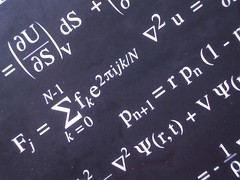 |
Our paper, Polarisation of Graded Bundles, with Janusz Grabowski and Mikołaj Rotkiewicz has now been published in SIGMA [1]. |
In the paper we show that Graded bundles (cf. [2]), which are a particular kind of graded manifold (cf. [3]), can be `fully linearised’ or `polarised’. That is, given any graded bundle of degree k, we can associate with it in a functorial way a k-fold vector bundle – we call this the full linearisation functor. In the paper [1], we fully characterise this functor. Hopefully, this notion will prove fruitful in applications as k-fold vector bundles are nice objects that that various equivalent ways of describing them.
Graded Bundles
Graded bundles are particular examples of polynomial bundles: that is we have a fibre bundle whose are \(\mathbb{R}^{N}\) and the admissible changes of local coordinates are polynomial. A little more specifically, a graded bundle $F$, is a polynomial bundle for which the base coordinates are assigned a weight of zero, while the fibre coordinates are assigned a weight in \(\mathbb{N} \setminus 0\). Moreover we require that admissible changes of local coordinates respect the weight. The degree of a graded bundle is the highest weight that we assign to the fibre coordinates.
Any graded bundle admits a series of affine fibrations
\(F = F_k \rightarrow F_{k-1} \rightarrow \cdots \rightarrow F_{1} \rightarrow F_{0} =M\),
which is locally given by projecting out the higher weight coordinates.
For example, a graded bundle of degree 2 admits local coordinates \((x, y ,z)\) of weight 0,1, and 2 respectively. Changes of coordinates are then, `symbolically’
\(x’ = x'(x)\),
\(y’ = y T(x)\),
\(z’ = z G(x) + \frac{1}{2} y y H(x)\),
which clearly preserve the weight.
We then have a series of fibrations
\(F_2 \rightarrow F_1 \rightarrow M\),
given (locally) by
\((x,y,z) \mapsto (x,y) \mapsto (x)\).
Linearisation
The basic idea of the full linearisation is quite simple – I won’t go into details here. Recall the notion of polarisation of a homogeneous polynomial. The idea is that one adjoins new variables in order to produce a multi-linear form from a homogeneous polynomial. The original polynomial can be recovered by examining the diagonal.
As graded bundles are polynomial bundles, and the changes of local coordinates respect the weight, we too can apply this idea to fully linearise a graded bundle. That is, we can enlarge the manifold by including more and more coordinates in the correct way as to linearise the changes of coordinates. In this way we obtain a k-fold vector bundle, and the original graded bundle, which we take to be of degree k.
So, how do we decide on these extra coordinates? The method is to differentiate, reduce and project. That is we should apply the tangent functor as many times as is needed and then look for a substructure thereof. So, let us look at the degree 2 case, which is simple enough to see what is going on. In particular we only need to differentiate once, but you can quickly convince yourself that for higher degrees we just repeat the procedure.
The tangent bundle \( T F_2\) – which we consider the tangent bundle as a double graded bundle – admits local coordinates
\((\underbrace{x}_{(0,0)}, \; \underbrace{y}_{(1,0)} ,\; \underbrace{z}_{(2,0)} \; \underbrace{\dot{x}}_{(0,1)}, \; \underbrace{\dot{y}}_{(1,1)} ,\; \underbrace{\dot{z}}_{(2,1)})\)
The changes of coordinates for the ‘dotted’ coordinates are inherited from the changes of coordinates on \(F_2\),
\(\dot{x}’ = \dot{x}\frac{\partial x’}{\partial x}\),
\( \dot{y}’ = \dot{y}T(x) + y \dot{x} \frac{\partial T}{\partial x}\),
\(\dot{z}’ = \dot{z}G(x) + z \dot{x}\frac{\partial G}{\partial x} + y \dot{y}H(x) + \frac{1}{2}y y \dot{x}\frac{\partial H}{\partial x}\).
Thus we have differentiated.
Clearly we can restrict to the vertical bundle while still respecting the assignment of weights – one inherited from \(F_2\) and the other comes from the vector bundle structure of a tangent bundle. In fact, what we need to do is shift the first weight by minus the second weight. Technically, this means that we no longer are dealing with graded bundles, the coordinate \(\dot{x}\) will be of bi-weight (-1,1). However, the amazing thing here is that we can set this coordinate to zero – as we should do when looking at the vertical bundle – and remain in the category of graded bundles. That is, not only is setting \(\dot{x}=0\) well-defined, you see this from the coordinate transformations; but also this keeps us in the right category. We have preformed a reduction of the (shifted) tangent bundle.
Thus we arrive at a double graded bundle \(VF_2\) which admits local coordinates
\((\underbrace{x}_{(0,0)}, \; \underbrace{y}_{(1,0)} ,\; \underbrace{z}_{(2,0)}, \; \underbrace{\dot{y}}_{(0,1)} ,\; \underbrace{\dot{z}}_{(1,1)})\),
and the obvious admissible changes thereof.
Now, observe that we have the degree of \(z\) as (2,0), which is the coordinate with the highest first component of the bi-weight. Thus, as we have the structure of a graded bundle, we can project to a graded bundle of one lower degree \(\pi : VF_2 \rightarrow l(F_2)\). The resulting double vector bundle is what we will call the linearisation of \(F_2\).
So we have constructed a manifold with coordinates
\((\underbrace{x}_{(0,0)}, \; \underbrace{y}_{(1,0)}, \; \underbrace{\dot{y}}_{(0,1)} ,\; \underbrace{\dot{z}}_{(1,1)})\),
with changes of coordinates
\(x’ = x'(x)\),
\(y’ = y T(x)\)
\( \dot{y}’ = \dot{y}T(x)\),
\(\dot{z}’ = \dot{z}G(x) + y \dot{y}H(x)\).
Then, by comparison with the changes of local coordinates on \(F_2\) you see that we have a canonical embedding of the original graded bundle in its linearisation as a ‘diagonal’
\(\iota : F_2 \rightarrow l(F_2)\),
by setting \(\dot{y} = y\) and \(\dot{z} = 2 z\).
References
[1] Andrew James Bruce, Janusz Grabowski and Mikołaj Rotkiewicz, Polarisation of Graded Bundles, SIGMA 12 (2016), 106, 30 pages.
[2] Janusz Grabowski and Mikołaj Rotkiewicz, Graded bundles and homogeneity structures, J. Geom. Phys. 62 (2012), 21-36.
[3] Th.Th. Voronov, Graded manifolds and Drinfeld doubles for Lie bialgebroids, in Quantization, Poisson Brackets and Beyond (Manchester, 2001), Contemp. Math., Vol. 315, Amer. Math. Soc., Providence, RI, 2002, 131-168.